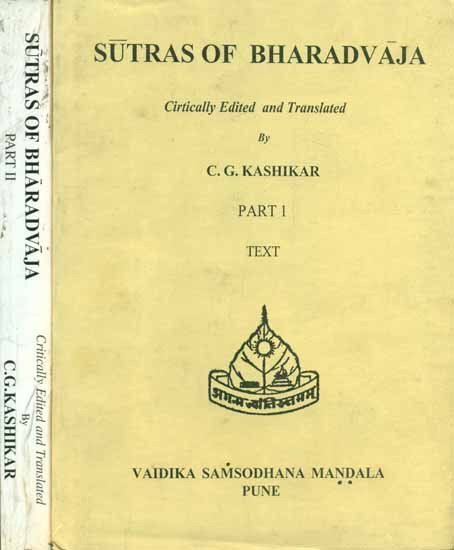Bharadvaja-srauta-sutra
by C. G. Kashikar | 1964 | 166,530 words
The English translation of the Bharadvaja-Srauta-Sutra, representing some of the oldest texts on Hindu rituals and rites of passages, dating to at least the 1st millennium BCE. The term Srautasutra refers to a class of Sanskrit Sutra literature dealing with ceremonies based on the Brahmana divisions of the Veda (Sruti). They include Vedic rituals r...
Praśna 3, Kaṇḍikā 3
1. The sacrificer should touch (the remaining portion of) the cake offered to Agni which the Adhvaryu has placed on the Barhis. We shall explain it in the Yājamāna section.[1]
2. He should divide it fourfold and assign those four portions: “This (belongs) to the Brahman, this to the Hotṛ, this to the Adhvaryu, and this to the Āgnīdhra.”[2]
3. The Adhvaryu should assign the sacrificer’s portion: “This to the sacrificer.”
4. These portions should be larger than those for the Iḍā.
5. After having assigned the portions, the Adhvaryu should give to the Āgnīdhra[3] his portion in six cuttings.
6. He should spread out clarified butter as base, cut out a part of the portion (and put it on the palm), pour out clarified butter on it, again spread out clarified butter as base, cut out another part, and pour out clarified butter on it. In this way he should accomplish the six cuttings.[4]
7. The Āgnīdhra should consume (his portion) with the formula, “The father heaven is called; may father heaven call me; Agni is called for the portion of the Āgnīdhra for long life, splendour, life, and good.”[5]
8. The Adhvaryu should carry the portions of the Brahman and the sacrificer by means of the veda.
9. He should carry the Hotṛ’s portion by means of another (pot), and the Adhvaryu’s portion by means of still another (pot).
10. The Hotṛ should consume his portion with the formula, “Thou art a share of earth;” the Adhvaryu with the formula, “Thou art a share of the mid-region;” the Brahman should consume his portion at the end of the sacrifice with the formula, “Thou art a share of heaven.”
11. The Adhvaryu should cook rice in large quantity on the Anvāhāryapacana fire,[6] pour out or not pour out clarified butter on it, take it down, and place it within the altar. The sacrificer should touch it. We shall explain it in the Yājamāna section.[7]
Footnotes and references:
[1]:
IV.16.2.
[2]:
According to Āpastamba-śrauta-sūtra III.3.4, the assigning should optionally commence with the Āgnīdhra or the Hotṛ.
[4]:
[5]:
Taittirīya-brāhmaṇa III.7.6.15. Āpastamba-śrauta-sūtra III.3.8 prescribes a different formula for this: “Thou art the Āgnīdhra fire; thou art the Śāmitra fire; obeisance to thee; do thou not injure me.”
[6]:
Āpastamba-śrauta-sūtra III.3.13 prescribes that, according to some teachers, it should be cooked in milk.
[7]:
IV.16.3.
